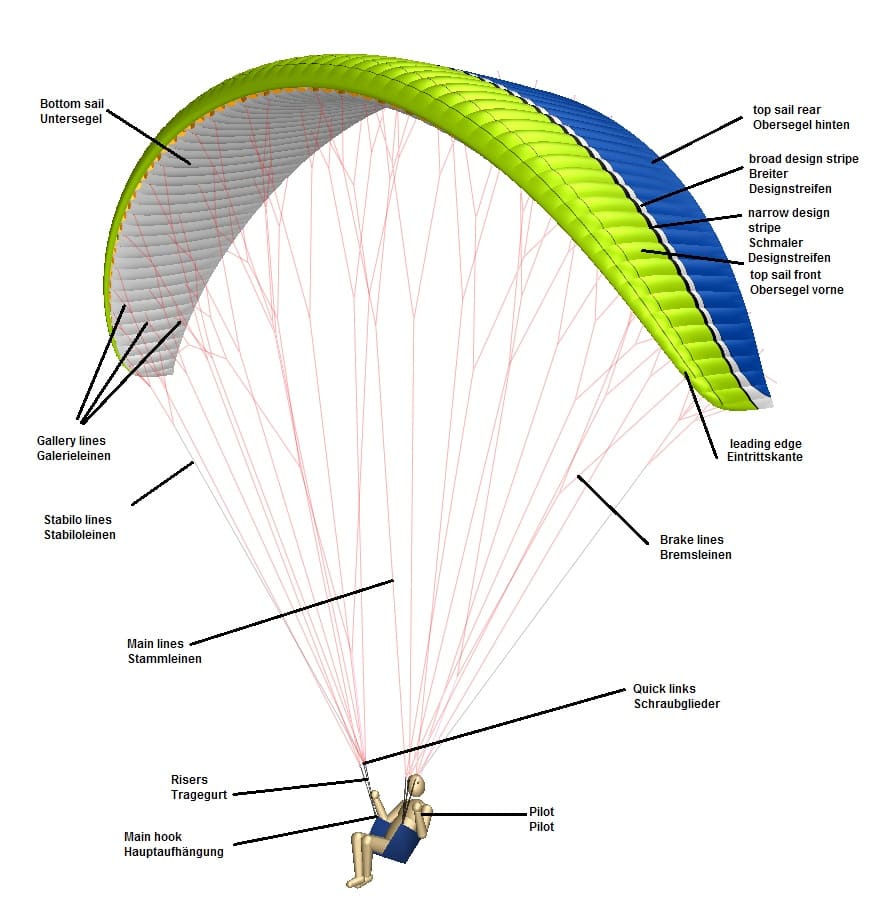Delve into the intricate world of paraglider design and discover the elements that make up this remarkable flying apparatus. A paraglider is not just a piece of equipment; it's an engineering marvel that combines aerodynamics, material science, and safety measures. The core components include:
- Wing: The heart of the paraglider, featuring an elliptical, aerodynamic shape distinct from a parachute. Made of durable, air-impermeable synthetic fabric, its two-layer construction with vertical ribs creates air-filled sections for lift.
- Lines and Risers: The intricate line system, including load-bearing and control lines, connects the wing to the pilot. These are crafted from materials such as polyester or Kevlar for added strength and stability.
- Harness System: Designed for comfort and safety, it includes a seat with lumbar support and safety belts, ensuring a secure and responsive connection to the wing.
- Accelerator: This mechanism allows pilots to adjust the paraglider's speed by altering the wing's angle.
- Emergency Parachute: A critical safety feature for unforeseen circumstances, it's easily deployable and designed for rapid opening.
- Helmet: An essential component for pilot safety, ensuring protection during all flights.
The paraglider's lifespan typically spans around 300 hours of flying, during which its materials and components maintain optimal performance. Understanding these elements is crucial for both aspiring and experienced paragliders, as it enhances both the safety and enjoyment of the sport.

The paraglider is an inflatable wing. In some ways, it resembles a parachute, but its shape is elliptical, strongly elongated, and not round. The wings are made of a special material that prevents air from passing through - durable synthetic fabric. Two layers of material are sewn together with a gap between them. Vertical ribs of fabric hold two layers together to form separate sections. An open leading edge allows air to enter the sections freely. Sections work like air traps, filling the entire wing until the formation of the correct aerodynamic shape. Experts agree that most wings have a life of approximately 300 flying hours (about four years) before the materials begin to stretch or weaken.
The line system is attached to various areas of the lower wing edge, proportionally distributing the load over the entire surface. Modern paragliders are equipped with three rows of load-bearing lines. Another row - several control lines are attached along the trailing edge. Lines in rows cascade down to the bottom, connecting on both sides of the pilot. The lines end (risers) with power belts of the free ends for which the suspension system is fastened with carbines. The control lines end with brake handles. By controlling the brakes, the pilot changes the direction or speed of the paraglider. The braid of the lines is made of synthetic materials such as polyester or nylon. Core - power threads inside of Kevlar are strong and durable. These types of materials are resistant to stretching and compression, which gives the paraglider stability and balance.
The harness system is designed to provide maximum comfort, featuring a comfortable seat with lumbar support and safety through safety belts, as well as the ability to transfer pilot control actions to the wing clearly.
The pilot uses the accelerator to increase the speed of the paraglider. It is attached to the suspension system and connected to the rows of lines using hooks. When you press the accelerator with your foot, the pilot can increase the speed of the paraglider by changing the angle of the wing.
An emergency parachute is used in unlikely, but possible, unforeseen flight circumstances when the wing becomes uncontrollable, starts to decline irretrievably, or there is a risk of its destruction. The reserve parachute is installed in a special compartment within the suspension system and is attached to it by a power halyard. It is protected from accidental deployment and undergoes regular checks. The reserve parachute is designed to open quickly when ejected.
And of course, a pilot who never flies without a helmet!
